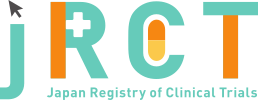臨床研究等提出・公開システム
|
May. 29, 2023 |
|
|
Mar. 01, 2025 |
|
|
jRCTs031230102 |
Evaluation of treatment satisfaction after switching from topical steroid to delgocitinib ointment-dominated treatment for skin rashes on the trunk and limbs in atopic dermatitis. |
|
Evaluation of treatment satisfaction after switching to delgocitinib ointment for trunk and limbs rash in atopic dermatitis. |
|
April. 27, 2024 |
|
101 |
|
101 patents (44 males, 57 females), mean age 35.1 years (males: 34.2 years, females: 35.8 years), who provided written informed consent, were enrolled in this clinical study. The mean age of the study participants at enrollment was 34.9+-12.5 years, and the mean duration of atopic dermatitis (AD) was 21.4+-13.8 years. There were no significant differences in these background characteristics between males and females. The mean EASI score was 9.60+-8.82, and the mean mEASI score for the trunk and extremities was 8.82+-8.22. |
|
93 patients were included in the analysis, excluding 1 patient who withdrew consent after enrollment, 1 patient who did not attend the clinic after enrollment, 4 patients who violated eligibility criteria due to the use of prohibited concomitant medications, and 2 patients who met the exclusion criteria. 5 patients discontinued the study due to exacerbation of skin lesions: 4 due to exacerbation of facial and neck lesions, and 1 due to exacerbation of lesions on other parts of the body. No clear trends were observed in the background characteristics, prior treatments, or disease severity among the 5 patients who discontinued the study. |
|
There was 1 AE (SE) considered to be related to this clinical study (folliculitis) in one patient. This event did not affect the continuation of the study and was resolved. Eighteen other adverse events occurred; however, none were considered related to this study, and none caused any problems in the clinical course. |
|
Primary endpoint: Treatment satisfaction (TSQM-9) Changes in the TSQM-9 score from week 0 (baseline) to week 12 after the start of treatment showed significant improvement in overall satisfaction and satisfaction with convenience at week 12 compared to baseline, indicating improved treatment satisfaction. Although there was no significant difference in satisfaction with effectiveness, an increasing trend was observed. Secondary endpoints Changes in skin lesions and pruritus: Switching to delgocitinib ointment showed a significant improvement in skin lesions (EASI score, mEASI score) and pruritus (NRS score) over time after the start of treatment. Patient control: Assessment using the ADCT showed that switching to delgocitinib ointment maintained good disease control throughout the observation period. Local side effects: Local side effects such as skin atrophy and telangiectasia observed with previous treatments were significantly reduced by switching to delgocitinib ointment. Improvement was also observed in rosacea-like dermatitis and erythema. Treatment preference and skin condition: Many patients felt that delgocitinib ointment was more effective, easier to use, and had fewer side effects. Significant improvements were also observed in various aspects of skin condition, including dryness, texture, firmness/elasticity, and appearance. |
|
This study assessed the effectiveness of switching from topical corticosteroids to delgocitinib ointment in AD patients with trunk and extremity lesions. Delgocitinib showed positive results in improving lesions, reducing side effects, and increasing patient satisfaction. This suggests delgocitinib is a good option for AD patients with trunk and extremity lesions experiencing side effects from topical corticosteroid use. |
|
Mar. 01, 2025 |
|
No |
|
No |
|
https://jrct.mhlw.go.jp/latest-detail/jRCTs031230102 |
Abe Masatoshi |
||
Sapporo Dermatology Clinic |
||
2-1-1, Minami3jonishi, Chuuou-ku, Sapporo-shi, Hokkaido |
||
+81-11-221-8807 |
||
masaabe@kojinkai.org |
||
Ryoichi Taguchi |
||
EBC&M LLC |
||
ShibaMatsuo Building 4F, 2-9-1, Shibakoen, Minato-ku, Tokyo, Japan |
||
+81-3-6435-3833 |
||
ryoichi_taguchi@ebc-m.com |
Complete |
May. 29, 2023 |
||
| July. 14, 2023 | ||
| 100 | ||
Interventional |
||
single arm study |
||
open(masking not used) |
||
uncontrolled control |
||
single assignment |
||
treatment purpose |
||
(1) Patients aged 18 years and older with atopic dermatitis when obtaining consent. |
||
(1) Patients using the strongest topical steroids. Using clobetasol propionate shampoo on the scalp is allowed. |
||
| 18age old over | ||
| No limit | ||
Both |
||
Atopic dermatitis |
||
Delgocitinib Ointment 0.5% (CORECTIM Ointment 0. 5%) will be applied topically twice daily for 4 weeks, limited to the area of the rash; if it is considered possible to increase the area of application at the 4-week visit, the maximum amount of study drug applied per dose will be limited to 5 g and the maximum amount applied to the trunk and limbs will be limited to 30% of the body surface area, taking into account the body size any topical products other than the study drug that has been applied to the trunk and limbs will be switched to the study drug and the area of application will be increased. |
||
Changes in patient satisfaction with treatment (TSQM-9) before and after starting delgocitinib ointment. |
||
Changes in skin rash on the whole body and at the site of application of the drug under study. (changes in EASI and mEASI) |
||
| Torii Pharmaceutical Co., Ltd | |
| Not applicable |
| Japan Aesthetic Dermatology Symposium Review Board | |
| Queens Tower C 8F, 2-3-5, Minatomirai, Nishi-ku, Yokohama City, Kanagawa, Japan, Kanagawa | |
+81-45-682-4114 |
|
| info@jp-ads.com | |
| Approval | |
May. 26, 2023 |
none |
